Complete Multielemental Analysis of Environmental and Geological Samples Using CCT-Based ICP-MS
Special Issues
The authors discuss the ICP-MS method, its usability in environmental and geological analysis and relevant regulations, and how to address its limitations.
Inductively coupled plasma–mass spectrometry (ICP-MS) has been established as the most appropriate method for routine environmental and geological applications, owing to its extended elemental coverage, superior sensitivity, and rapid analytical capabilities. Nevertheless, the technique's association with spectroscopic interferences remains, despite the fact that in recent years the introduction of collision–reaction cell (CRC) instrumentation has solved this shortcoming. This article will discuss the ICP-MS method, its usability in environmental and geological analysis and relevant regulations, and will build the case for the CRC approach as the most efficient solution addressing the limitations of ICP-MS. An experiment illustrates the flexibility and power of collision cell technology–based ICP-MS to analyze a variety of common environmental and geological sample matrices.
The inductively coupled plasma–mass spectrometry (ICP-MS) technique is based upon the coupling of an inductively coupled plasma, producing ions, and a mass spectrometer that separates and detects the ions. Argon gas (Ar) is used for the production of a plasma or gas consisting of ions, electrons, and neutral particles. Following dispersion into the stream of argon gas, samples are carried to the inductively coupled plasma, where their elements are atomized and ionized. The resulting ions are then passed through a series of apertures (cones) into a high-vacuum mass spectrometer where they are separated according to their mass-to-charge ratio (m/z) and counted. The isotopes of the elements are identified by their m/z. The intensity of a specific peak in the mass spectrum is proportional to the amount of that isotope in the original sample.
ICP-MS in Environmental and Geological Analysis
ICP-MS is a popular method, routinely used in both standard and high-sensitivity modes for fast and accurate measurements of trace (parts-per-million to parts-per-billion) and ultratrace (parts-per-billion to parts-per-quadrillion) elemental concentrations in a wide range of geological and environmental applications. The increasing popularity of the technique is attributed to the important benefits that it offers, including its multielemental capability compared with conventional elemental techniques, high sensitivity, superior detection limits, increased dynamic range, and isotopic ratioing capabilities. ICP-MS can be used to analyze both solid and liquid samples, requiring only small sample quantities thanks to its analytical range from the parts-per-trillion to the parts-per-million regions.
Used in conjunction with varying nebulization and calibration techniques, ICP-MS is applicable in both liquid and solid materials. This highly sensitive and powerful technique performs reliable trace element distribution analysis of geological materials; identification of ultratrace cesium (Cs) and rubidium (Rb) in hydrothermal pore waters; and monitoring of transition, trace, and heavy metal contamination in environmental water samples. Further applications include preliminary investigation into the determination of osmium (Os) in sea water, lead isotopic ratio determination in mud cores taken from salt marshes, and analysis of uptake fluxes of trace redox-sensitive elements from sea water in sediments. Regardless of the sample type, it is important that it is free of particulate matter, as even the smallest particle can disrupt sample flow and block or clog the sample tips within the spray chamber.
Having recognized the unparalleled sensitivity, precision, and reliability of ICP-MS, environmental protection regulatory bodies across the world have mandated the use of ICP-MS for a variety of applications.
Regulations
The U.S. Environmental Protection Agency (EPA) National Environmental Methods Index currently lists 11 approved ICP-MS methods by agencies within the United States. The most commonly used methods are those that have been developed by the EPA covering the use of ICP-MS for monitoring various elements in drinking water (Method 200.8), wastewater and solid waste (SW-846 Method 6020), and low-level trace in drinking water (Method 1638). In addition, the EPA has recognized ICP-MS as the only approved multielement method for determining arsenic and uranium in drinking water. The U.S. Department of Agriculture, Food Safety and Inspection Service, Office of Public Health Science has introduced Method CLG-TM3.01. This method specifies the use of ICP-MS for the analysis of cadmium (Cd) and lead (Pb) at parts-per-billion levels in beef, pork, and poultry muscle, liver, and kidney.
Although very powerful and widely recognized by regulatory agencies, ICP-MS presents a few limitations, including spectroscopic interferences.
Spectroscopic Interferences
Interferences are caused by polyatomic species that have similar mass to the target species and that stem from the sample matrix, Ar, or entrained gas. Solvents, reagents, glassware, and other sample processing hardware also can yield artifacts or interferences to sample analysis.
There are other types of interferences including isobaric elemental interferences that are caused by isotopes of different elements forming atomic ions with the same nominal m/z. Ions consisting of more than one atom or charge trigger the formation of isobaric molecular and doubly charged ion interferences, respectively. Physical interferences are associated with the sample nebulization and transport processes as well as with ion-transmission efficiencies. Memory interferences or carryover occur when there are large concentration differences between samples or standards that are analyzed sequentially.
Interferences limit the ability of ICP-MS to determine certain elements of interest while also increasing maintenance requirements and reducing the reliability and quality of the data produced. Eliminating interferences provides numerous advantages, including significantly improved detection limits for interfered analytes, analyte confirmation by isotope ratio measurement, and superior analytical confidence in complex matrices.
The combination of ICP-MS and collision–reaction cell (CRC) instrumentation has demonstrated a unique capability of significantly reducing and even eliminating interferences.
CRC Instrumentation
CRC instrumentation employs either passive collisional interactions in which no chemical reaction occurs, or reactive interactions in which the charge or structure of either the analyte or interferent are changed chemically. Collision-based instruments use an inert collision gas, helium (He), to reduce the kinetic energy of the polyatomic interferent, thus preventing it from entering the quadrupole analyzer. Reaction-based analyzers use a range of reactive gases, including hydrogen, methane, and ammonia, to chemically shift one member of the analyte–interferent pair to another mass.
Reaction and collision cells share the same technology, but where they differ is the regime established inside. Reactive chemistry can be applied to polyatomic species that react with the gas and consequently are either eliminated or modified. Additionally, reactive chemistry can modify analyte ions and analyze them at masses different from their natural isotope mass.
Collision instruments can separate all kinds of overlapping molecular and polyatomic analyte ions from monoatomic ions if they differ in kinetic energy. This process is based upon collisions using inert gases like He and is called kinetic energy discrimination (KED). Collision instruments using KED have the advantage of being universally able to reject all polyatomic interferences in any matrix and are therefore well suited to multielemental analysis in complex or unknown matrices.
Using ICP-MS in conjunction with state-of-the-art collision–reaction instrumentation can reduce spectral interferences efficiently and to negligible levels while the analytes remain relatively unaffected. Accurate analysis at low concentration levels can be performed even in difficult matrices. There are a number of spectral interferences that can be reduced with reactive chemistry, while others are better treated under KED conditions. For highest flexibility and best detection power in sample analysis, experiments should switch between several cell regimes.
Experimental
An experiment was developed to illustrate the flexibility and power of collision cell technology (CCT)-based ICP-MS to analyze a variety of common environmental and geological sample matrices.
Methodology
A Thermo Scientific XSERIES 2 ICP-MS system equipped with third-generation CCTED CRC instrumentation (Thermo Fisher Scientific, Bremen, Germany) was configured with an SC2 FAST automated sample introduction system (Elemental Scientific Inc., Omaha, Nebraska). The schematic in Figure 1 outlines the principle of the sample introduction system, which relies on a six-port switching valve to load and inject samples.
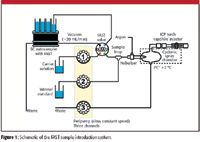
Figure 1
This system significantly reduces sample uptake and washout times and dramatically decreases matrix load that reaches the plasma. The ICP-MS instrumental parameters are shown in Table I. A universal H2 in He gas mixture was used in the collision–reaction cell for the suppression of interferences.

Table I: System parameters
Environmental Sample Analysis
The experimental methodology performed to test the high-throughput setup for environmental samples was based upon conditions outlined in the Multi-Media, Multi-Concentration, Inorganic Analytical Service for Superfund Method ILM05.4. This method was introduced by the EPA within the Contract Laboratory Program (CLP) for water and soil/sediment environmental analysis.
To improve the determination of analytes with a high ionization potential (such as Be, As, and Se), a stream of methane was added to the nebulizer gas. This carbon-loading enhances sensitivity for these analytes (Figure 2) and improves long-term stability by the reduction of matrix deposition on the ICP-MS interface.
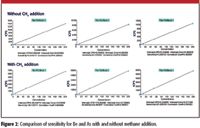
Figure 2
A sequence of 500 samples including a calibration and integrated QC (Table II) was performed for 23 analytes.
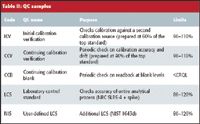
Table II: QC samples
A sample turnaround of approximately 83 s, including uptake, analysis, and wash, provided an overall batch acquisition time of 12 h for the entire 500 samples. Five samples (an interference check solution [ICSA], the same solution with a 20-ppb spike [ICSAB], NRC SLRS-3 river water reference material with varying spike concentrations, NIST 1643c reference material, and a detection limit check solution [CRI]) were classed as unknown samples and looped continuously throughout the experiment. The mean results for periodic analysis (every 20 unknowns) of the laboratory control standards (LCS) are shown in Table III.
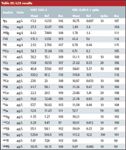
Table III: LCS results
The stability of the results for samples SLRS-3 + spike and NIST 1643c are shown in Figure 3.
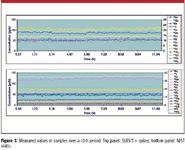
Figure 3
Geological Sample Analysis
Rock samples weighing 0.5 g were digested using an Aqua Regia mix (12.5 mL 30%) and diluted an additional 10 times before analysis. A sequence of 478 samples, including a calibration and integrated QC, was performed for 30 analytes. A sample turnaround, including uptake, analysis, and wash, of approximately 80 s resulted in an overall acquisition time of 11 h for the 478 samples. A standard operating procedure similar to the CLP method was followed, and a well-characterized rock was used as an LCS in the QC protocol along with a continuing calibration verification (CCV) and a continuing calibration blank (CCB). Five samples (an ICSA, the same solution with a 20-ppb spike, a rock sample [GEOMS], GEOMS spiked with varying analyte concentrations, and a CRI) were classed as unknown samples and looped continuously throughout the experiment. Results for the determination of analytes in the unknown samples over the 11-h period are shown in Figure 4.
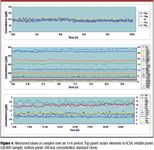
Figure 4
Discussion
When used with a universal gas mixture for all analytes, CCT-based ICP-MS has been demonstrated to be a multielemental technique with high-throughput capabilities. With methane addition, the analysis can benefit from an increase in sensitivity for analytes with a higher ionization potential, such as Be and Se, which are often at lower concentrations in environmental samples, as well as benefiting from an improvement in long-term stability. Throughput and stability are further improved and necessary maintenance is reduced thanks to the configured sample introduction system, which cuts uptake and washout time and introduces less matrix into the plasma over time.
Conclusion
CCT-based ICP-MS is a proven multielemental technique, capable of performing fast and accurate analyses of an extended range of common environmental and geological sample matrices. Through the use of a segmented flow sample introduction system, matrix deposition on the ICP-MS interface is reduced significantly, leading to increased first-time pass QC analyses and longer periods between necessary maintenance. Spectral interferences associated with the traditional ICP-MS method are reduced considerably, and sample throughput is increased.
Julian Wills, Shona McSheehy, Tomoko Oki, and Meike Hamester are with Thermo Fisher Scientific, Bremen, Germany. Bill Spence is with Thermo Fisher Scientific, Winsford, UK.
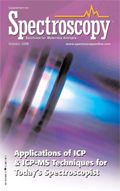
High-Speed Laser MS for Precise, Prep-Free Environmental Particle Tracking
April 21st 2025Scientists at Oak Ridge National Laboratory have demonstrated that a fast, laser-based mass spectrometry method—LA-ICP-TOF-MS—can accurately detect and identify airborne environmental particles, including toxic metal particles like ruthenium, without the need for complex sample preparation. The work offers a breakthrough in rapid, high-resolution analysis of environmental pollutants.
Trending on Spectroscopy: The Top Content of 2024
December 30th 2024In 2024, we launched multiple content series, covered major conferences, presented two awards, and continued our monthly Analytically Speaking episodes. Below, you'll find a selection of the most popular content from Spectroscopy over the past year.